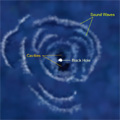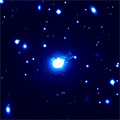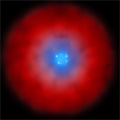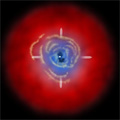CXC Home | Search | Help | Image Use Policy | Latest Images | Privacy | Accessibility | Glossary | Q&A

Animation of Sound Waves Generated in Perseus Cluster
QuickTime MPEG This animation shows how sound waves are generated in the Perseus cluster from its central supermassive black hole. The gas that fills the cluster of galaxies is shown in red. The animation then zooms in to show the cluster's central black hole, which is seen as a white point. Next, blue-white jets of high-energy particles and magnetic fields blow out from the black hole, forming dark cavities in the cluster gas. When these cavities slow down, sound waves break off and travel away from the cavities. The animation then dissolves into Chandra's X-ray image of the cluster.
[Run Time: 16 sec]
Animation: NASA/CXC/A.Hobart
X-ray Image: NASA/CXC/IoA/A.Fabian et al.
QuickTime MPEG This animation shows how sound waves are generated in the Perseus cluster from its central supermassive black hole. The gas that fills the cluster of galaxies is shown in red. The animation then zooms in to show the cluster's central black hole, which is seen as a white point. Next, blue-white jets of high-energy particles and magnetic fields blow out from the black hole, forming dark cavities in the cluster gas. When these cavities slow down, sound waves break off and travel away from the cavities. The animation then dissolves into Chandra's X-ray image of the cluster.
[Run Time: 16 sec]
Animation: NASA/CXC/A.Hobart
X-ray Image: NASA/CXC/IoA/A.Fabian et al.

Perseus Ripple Image Dissolving into Illustration
QuickTime MPEG This sequence begins with the Chandra data, which show the ripples inthe hot gas that fills the Perseus cluster. The features were discovered by using a special image-processing technique to bring outsubtle changes in brightness. These sound waves are thought to have been generated by cavities blown out by jets from a supermassive black hole(bright white spot) at the center of the Perseus cluster. The Chandra image then dissolves into an artist's illustration of the system, which labels the important features, before returning to the original Chandra data.
[Run Time: 15 sec]
X-ray Image: NASA/CXC/IoA/A.Fabian et al.
Illustration: NASA/CXC/M.Weiss
QuickTime MPEG This sequence begins with the Chandra data, which show the ripples inthe hot gas that fills the Perseus cluster. The features were discovered by using a special image-processing technique to bring outsubtle changes in brightness. These sound waves are thought to have been generated by cavities blown out by jets from a supermassive black hole(bright white spot) at the center of the Perseus cluster. The Chandra image then dissolves into an artist's illustration of the system, which labels the important features, before returning to the original Chandra data.
[Run Time: 15 sec]
X-ray Image: NASA/CXC/IoA/A.Fabian et al.
Illustration: NASA/CXC/M.Weiss

Optical Perseus Image Dissolving into X-ray Image
QuickTime MPEG This sequence of two images begins with an optical, ground-based image of the Perseus galaxy cluster. At the center of the image is Perseus A, a large elliptical galaxy. The Chandra X-ray Observatory image shows the supermassive black hole at the center of Perseus A, seen as a white point. The hot cluster gas is seen as diffuse emission, and two cavities in the cluster gas are visible on either side of the black hole.
[Run Time: 6 sec]
Optical Image: Isaac Newton Group of Telescopes, La Palma
X-ray Image: NASA/CXC/IoA/A.Fabian et al.
QuickTime MPEG This sequence of two images begins with an optical, ground-based image of the Perseus galaxy cluster. At the center of the image is Perseus A, a large elliptical galaxy. The Chandra X-ray Observatory image shows the supermassive black hole at the center of Perseus A, seen as a white point. The hot cluster gas is seen as diffuse emission, and two cavities in the cluster gas are visible on either side of the black hole.
[Run Time: 6 sec]
Optical Image: Isaac Newton Group of Telescopes, La Palma
X-ray Image: NASA/CXC/IoA/A.Fabian et al.

Artist's Representation of "Cooling Flows" in Galaxy Clusters
QuickTime MPEG The detection of intergalactic sound waves may solve the long-standing mystery of why the hot gas in the central regions of the Perseus cluster has not cooled over the past ten billion years to form trillions of stars. This graphic contains a series of four illustrations to show how "cooling flows" are expected to affect the structure of galaxy clusters. The hot, X-ray emitting gas that fills the cluster is shown in red. Next, the gas near the center of the cluster radiates energy and cools, which is shown as blue. The resulting inward flow of gas should cause higher densities toward the center of the cluster (brighter blue), and the final frame shows how this is expected to generate prodigious star formation.
[Run Time: 10 sec]
Illustrations: NASA/CXC/M.Weiss
QuickTime MPEG The detection of intergalactic sound waves may solve the long-standing mystery of why the hot gas in the central regions of the Perseus cluster has not cooled over the past ten billion years to form trillions of stars. This graphic contains a series of four illustrations to show how "cooling flows" are expected to affect the structure of galaxy clusters. The hot, X-ray emitting gas that fills the cluster is shown in red. Next, the gas near the center of the cluster radiates energy and cools, which is shown as blue. The resulting inward flow of gas should cause higher densities toward the center of the cluster (brighter blue), and the final frame shows how this is expected to generate prodigious star formation.
[Run Time: 10 sec]
Illustrations: NASA/CXC/M.Weiss

Artist's Representation of Sound Waves Preventing a Cooling Flow in Perseus
QuickTime MPEG This graphic contains a series of three illustrations to show how a "cooling flow" in the Perseus cluster, and the resulting star formation, is prevented by sound waves generated by the central black hole. The hot, X-ray emitting gas that fills the cluster is shown in red. Next, the gas near the center of the cluster radiates energy and cools, which is shown as blue. The third frame shows heating by the sound waves, shown in yellow, preventing further cooling of the gas. This stops the inward flow of gas expected in a cooling flow, preventing new star formation.
[Run Time: 8 sec]
Illustrations: NASA/CXC/M.Weiss
QuickTime MPEG This graphic contains a series of three illustrations to show how a "cooling flow" in the Perseus cluster, and the resulting star formation, is prevented by sound waves generated by the central black hole. The hot, X-ray emitting gas that fills the cluster is shown in red. Next, the gas near the center of the cluster radiates energy and cools, which is shown as blue. The third frame shows heating by the sound waves, shown in yellow, preventing further cooling of the gas. This stops the inward flow of gas expected in a cooling flow, preventing new star formation.
[Run Time: 8 sec]
Illustrations: NASA/CXC/M.Weiss
Return to Perseus Cluster (9 Sep 03)


